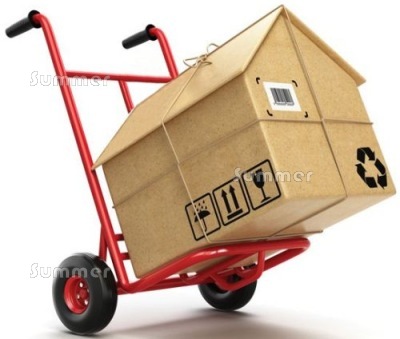Click this messge to hide it.
This useful guide contains information and advice about all aspects of your delivery. Please take a few minutes to read it. Also, please print it or save it on your computer for future reference. You should also have received our Important Product Information with comprehensive advice and useful tips to help you enjoy your purchase to the full. Please contact us if you have not received it.
CONTENTS
Scroll down or click on the links below:
- YOUR PALLET DELIVERY
- THE LORRY
- THE PALLET TRUCK
- TAIL LIFT DELIVERY
- THE DRIVER
- ROADSIDE DELIVERY
- RECEIVING YOUR DELIVERY
- HELPFUL ADVICE
- THE PALLET NETWORKS
YOUR PALLET DELIVERY
Your order includes delivery using a national pallet distribution network.
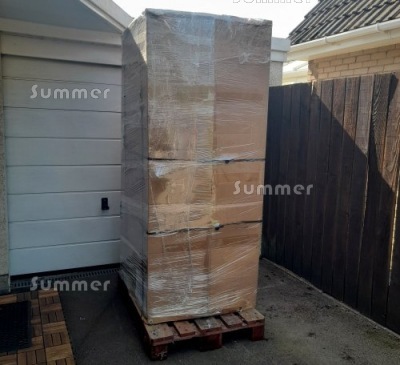
PICTURE: A large box on a single pallet unloaded onto a drive.
- Single pallets are small enough to be unloaded quickly and easily with a hydraulic tail lift and a pallet truck.
- Single pallets are up to 4'x4' (1.2m x1.2m) in area and up to 7'6" (2.3m) high.
- Single pallets are easier to unload than our larger pallets with fewer problems.
- We specify that the lorry must have a hydraulic tail lift at the rear of the lorry for easy off-loading.
- The driver can normally lower the entire pallet to the ground in a few minutes without assistance.
- Once the pallet is on the ground it can be moved with a hydraulic pallet truck.
- The driver may be able to move the pallet some distance away from the lorry over a smooth flat surface such as a road or drive.
- Suitable surfaces include block paving and smooth new tarmac or concrete.
- Unsuitable surfaces include shingle or gravel, crumbling old concrete or tarmac and soil, however well compacted.

PICTURE: Multiple boxes on a single pallet, delivered using a tail lift and a pallet truck.
You will be contacted again before the delivery to advise when your order is dispatched.
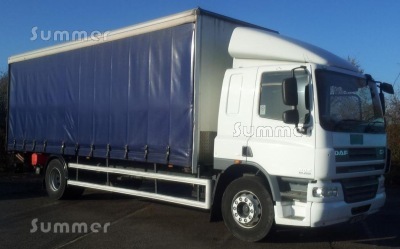
PICTURE: A typical pallet delivery lorry.
THE LORRY
- The delivery vehicle is normally a rigid lorry around 10m (33ft) long with curtain sides.
- The lorry is approximately the same length as 2 cars parked in line, but please allow 3 car lengths for manoeuvering.
- The back of the lorry is normally around 8m (27ft) long.
- Please advise if lorry access is difficult at your property.
- Reasonable access to your property and parking directly outside is assumed.
- Please advise if there are any low bridges, narrow bridges, weight limits, width limits, parking restrictions, unloading restrictions or narrow lanes at or near your property.
- Our lorry is bigger than a large bin lorry. Please advise if a large bin lorry cannot easily park outside your property.
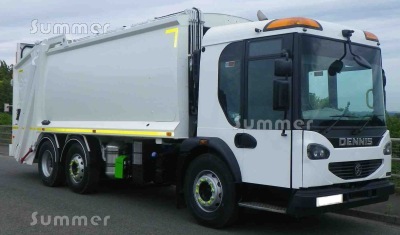
PICTURE: A large bin lorry.
THE PALLET TRUCK
- Pallets are delivered by one driver using a hydraulic pallet truck, also called a pump truck.
- When the handle is pumped up and down the pallet is raised off the ground so it can be moved.
- Pallets are unloaded at the kerbside outside your property. It is normally possible to move the pallet onto your drive if the surface is suitable.
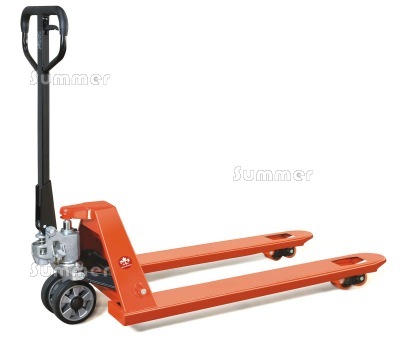
PICTURE: A pallet truck.
- A pallet truck can only move over a very smooth and flat surface. Unlike pneumatic tyres the small solid wheels cannot overcome surface irregularities. Even a tiny piece of pea shingle can stop a pallet truck.
- It is not normally possible to manoeuvre a pallet truck over steps or steep slopes.
- It is not normally possible to manoeuvre a pallet through a gate or entrance less than 4ft (1.2m) wide.
- If you have a flat drive with good access for cars and a hard smooth surface such as block paving, tarmac or concrete it is normally possible for the driver to leave your pack in a corner of the drive.
- The heavier the pallet is the harder it is to move, especially over a rough surface. Lighter pallets can be dragged over a kerb or for a short distance across gravel.
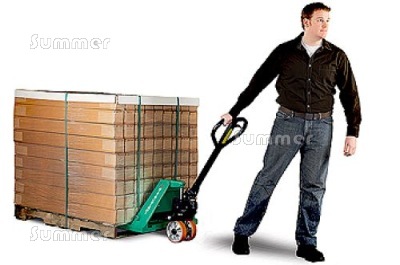
PICTURE: A pallet truck in use to move a loaded pallet.
- If you do not have a drive, if your drive slopes steeply or if the drive surface is not smooth enough for a pallet truck it may not be possible to leave the pack inside your property. In such cases we recommend a pavement delivery. This ensures that the delivery can be completed without any re-delivery charges.
- The driver will always find somewhere at or near your property to unload the pallet. Occasionally the best place is in the drive entrance blocking access for cars or on the pavement outside. Occasionally, if the road is wide enough, the best place is on the road alongside the kerb.
- Unless you live in a no loading area or an urban clearway you are entitled to receive a pavement or roadside delivery.
- You are also entitled to a reasonable time in which to move the individual components from the kerbside after a delivery.
TAIL LIFT DELIVERY
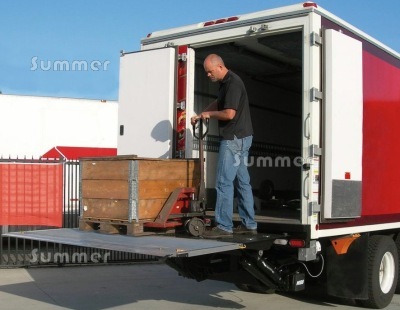
PICTURE: A pallet truck in use to move a loaded pallet, just after lowering it onto a tail lift.
- At most properties a pallet can remain on the drive for hours. However, if a pallet is delivered onto the pavement somebody may need to empty the pallet and move the individual components quickly.
- Even if the driver leaves the pack on your drive, many people move the individual components for security reasons. So whether your pack is delivered to the drive or the pavement it will often be moved on the day of delivery.
- It takes less time to empty a pallet and move the components only a few feet if required to clear the road, the pavement or a drive entrance. It may take much longer to move the components into the back garden.
- We always request a lorry with a tail lift. Occasionally if the lorry is full your pallet may be blocked from the tail lift. If so, ask the driver to return later. If this is not possible you may agree to unload the pallet by hand. If you are in a hurry this may be a better option than waiting for re-delivery. It is not much extra work if the pallet needs to be moved anyway. Unloading a pallet by hand normally takes only a few minutes.

PICTURE: A loaded pallet on a tail lift, still raised while being moved, about to be lowered to the ground.
THE DRIVER
- Take advantage of the driver and their pallet truck while you can.
- Make sure the pallet is pushed as far into your property as possible. If required help the driver push it further. It could save you time later.
- Most drivers are happy to help, especially if the unloading was completed quickly and easily.
- We cannot guarantee the response of every driver but many will be happy to help you if you ask. It could save you a lot of effort.
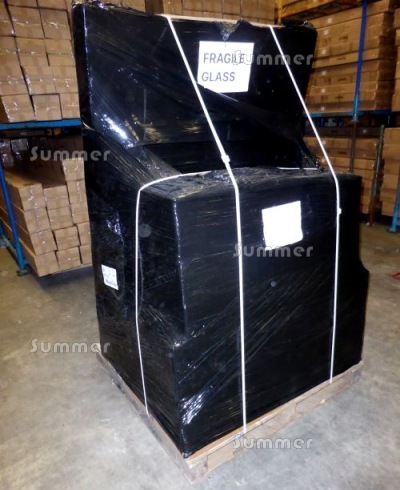
PICTURE: Multiple boxes loaded on a single pallet and wrapped.
ROADSIDE DELIVERY
- If you do not have a drive, if your drive slopes steeply or if the drive surface is not smooth enough for a pallet truck it may not be possible to leave the pack inside your property. In such cases we recommend a pavement delivery. This ensures that the delivery can be completed without any re-delivery charges.
- The driver will always find somewhere at or near your property to unload the pallet. Occasionally the best place is in the drive entrance blocking access for cars or on the pavement outside. Occasionally, if the road is wide enough, the best place is on the road alongside the kerb.
- A pallet can be delivered on the road if the road is wide enough and the pallet is not an obstruction.
- If your pallet is delivered on the road the best place is directly in front of your car if it is legally parked. You should leave your car there until after the individual components have been moved off the road.
- Unless you live in a no loading area or an urban clearway you are entitled to receive a pavement or roadside delivery.
- You are also entitled to a reasonable time in which to move the individual components from the kerbside after a delivery.
- A roadside delivery should be moved before nightfall to avoid blocking the road or pavement.
RECEIVING YOUR DELIVERY
- If you expect somebody else to receive the delivery on your behalf, please email this guide to them or print a copy and give it to them.
- Check the goods for any visible damage before signing the delivery note.
- If there is minor damage please do not refuse the delivery but add the word "damaged" next to your signature.
- There is always space on a delivery note or a hand held device to add a brief note.
- If you are out for the delivery, check the number of cartons and the condition of the packaging on the day of delivery.
- Any damage must be reported on the day of delivery. Please CLICK HERE to Contact Us.
- Please email a photograph of any damage to enquiries@summergardenbuildings.co.uk. This makes processing a claim faster.
- When signing for the goods, never use the words "unchecked" or "not checked", which are often interpreted as "received in good condition".
- Since the Covid-19 pandemic, there is often no requirement to physically sign for goods. However, you are still receiving a delivery whether you sign something or not. You should report any damage or suspected damage to the driver and ask to see evidence that your concerns have been noted. If you are not reassured please advise us promptly on the day of delivery.
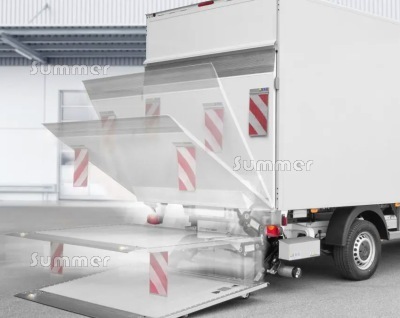
PICTURE: A photomontage showing the operation of a large hydraulic tail lift.
HELPFUL ADVICE
- You should do what you can to ensure that delivery companies and installers do not make unproductive trips to the site. For example, if the delivery is late you may need to warn the fitter not to visit.
- The delivery company assumes that there is good access at your property, so if it is not possible to complete your delivery at the first attempt you may be liable to pay for a second delivery. You should not allow the delivery to proceed unless it can be successfully completed.
- Any installer normally assumes a clear site with ample working space and good access from the point of delivery with no restrictions, so if it is not possible to carry out the installation at the first attempt you may be liable to pay for a second visit. You should not allow the installer to visit unless the work can be successfully completed.
- Some installers choose not to carry heavy or bulky components through the house, due to the risk of damage to the product or your property.
- Most installers choose not to lift heavy or bulky components over obstructions such as a wall, a fence or a garage roof, due to the risk of damage.
- If you need any heavy or bulky components to be carried through the house or lifted over an obstruction, we recommend discussing it with your installer. If there is no other option you may need to carry those components yourself or find somebody who can help.
- Our expert advisers can help you with advice so please contact us with any queries.
THE PALLET NETWORKS
The only way we can deliver our pallets throughout the UK within a day or two is using national pallet networks. The service is better than the parcel networks we use for smaller deliveries, with fewer delays and much less damage. The vast majority of pallets are delivered on time and intact, but not all of them. If you are one of the unlucky ones we can only apologise and try to resolve the problem. It can be very annoying if a delivery is late or damaged. Unfortunately we cannot operate without the national pallet networks and we cannot change them. Although it does not solve anything we thought it may help you to understand a little about how they operate:

PICTURE: The central hub of a national pallet network late at night, full of pallets and trunkers being loaded and unloaded.
- National pallet networks are normally based on a bicycle wheel structure, with one central hub and lots of spokes, each leading to a local depot.
- Every day each depot collects pallets from within its own local area, which are delivered to the central hub that night.
- After each trunker lorry has been unloaded at the hub, it is loaded with pallets which need to be delivered by that depot in its local area on the following day.
- Early the next morning, the trunker lorries return to the depot with all of the pallets their depot needs to deliver that day in their local area.
- The pallets are then loaded into smaller lorries, each of which delivers and collects within a small patch of the local area.
- The local depot based near us in Norwich collects from us every day and delivers your pallet to the central hub.
- The final stage of the journey is delivery to you by your local depot.
- Every day two national networks collect pallets from our warehouses.
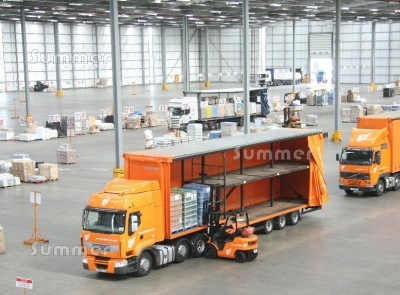
PICTURE: A network hub in the early hours, with fewer trunkers to process and most of the pallets already on their way.
- Damage is far less frequent than parcel networks because each pallet occupies its own space on the lorry.
- The pallets are picked up by forklifts and pallet trucks with no manual handling.
- With each pallet picked up and set down a minimum of eight times as it travels through the network, there is always a chance of damage or routing errors.
- Although the service for pallets is more reliable than parcels, on busy nights the networks do not always have enough space on the lorries for every pallet to every area. If a backlog develops overnight it may not be cleared until the next day and some pallets may be delayed by a day.
- Occasionally on the busiest nights the hubs are overwhelmed. This means there are more pallets than the network can deliver on the following day, so some pallets are delayed. Most delayed pallets follow on a day later than expected.
- The busiest night every week is often Thursday night, with extra pallets wanted by domestic customers on Friday for use at the weekend.
- The busiest nights of all are the night before a bank holiday weekend.
- It is not possible to forecast the spikes in demand with any degree of certainty. For example, when the sun comes out far more people buy garden products.
- The best way to avoid the rush is to order a few days earlier.

PICTURE: Articulated double decker trunkers deliver to and from the network hubs each night.
- The majority of pallet deliveries are business to business.
- Domestic pallet deliveries have grown fast in recent years, primarily due to national online retailers of bulky products, such as us.
- Most business to business deliveries are completed effortlessly within a few minutes, because most businesses have a forklift and easy access for lorries.
- The drivers get to know each business on their patch and often collect or deliver every day from the same premises and the same industrial estates.
- Occasionally, business to business deliveries are awkward if the business has no forklift or if lorry access is difficult. To deal with this, many of the pallet lorries feature a hydraulic tail lift, which allows the driver to unload the pallet quickly and easily without assistance using a manual pallet truck. It is this aspect of the pallet service which we utilize.
- Domestic deliveries are more challenging due to restricted lorry access at some addresses, properties with no drive, drive surfaces which are unsuitable for pallet trucks and customers who are away at work on weekdays.
- Our logistics team are expert at overcoming any obstacles.
THANK YOU FOR SHOPPING WITH SUMMER GARDEN BUILDINGS
We produced these guidance notes in order to inform and reassure our customers, with detailed advice about many aspects of the delivery. However, despite our best efforts to provide comprehensive and accurate information and to update the details as required it is not always possible to describe in advance every situation which may arise. We apologise if your specific circumstances or queries are not adequately covered. All timescales are approximate and any procedures described may be subject to change. Please contact us if you have any queries.
